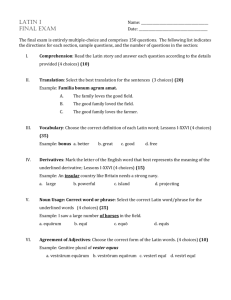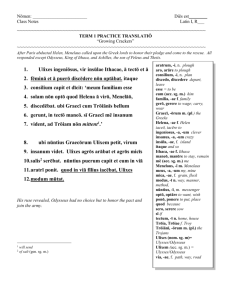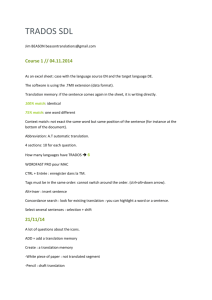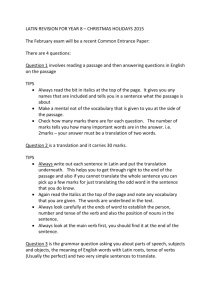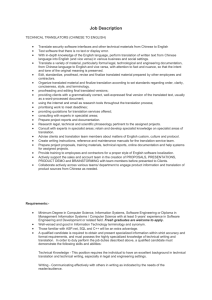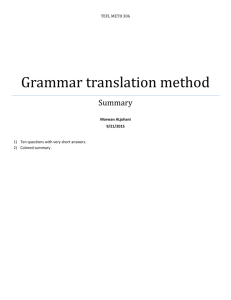Latin 2 Translatio Practice
advertisement
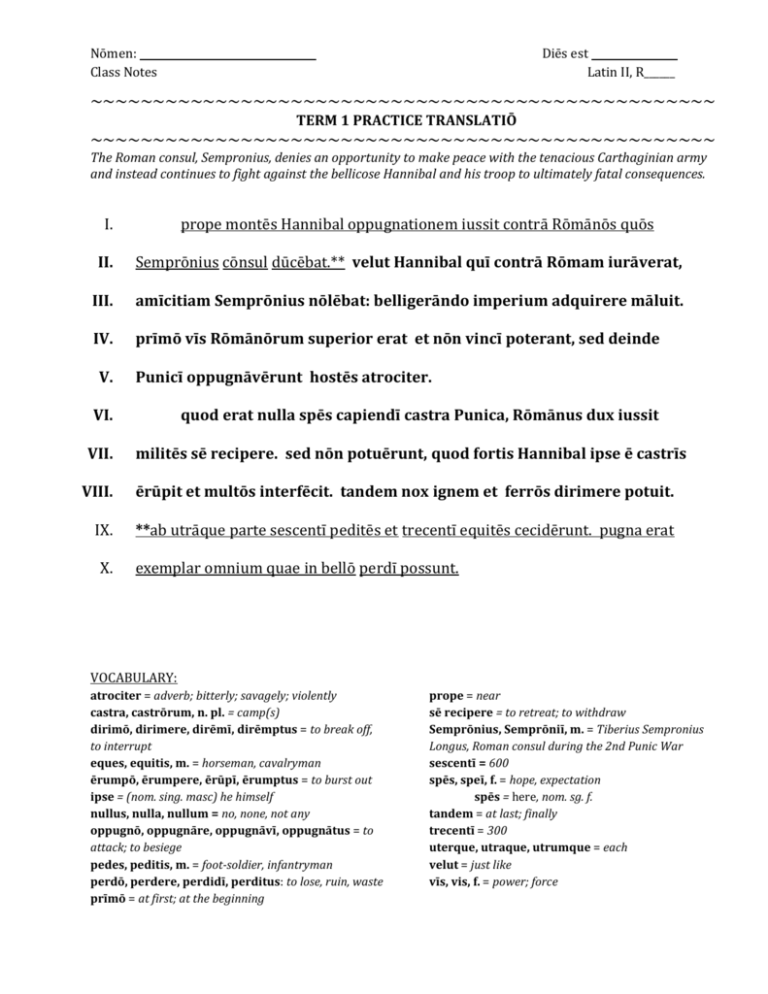
Nōmen: Class Notes Diēs est Latin II, R______ ~~~~~~~~~~~~~~~~~~~~~~~~~~~~~~~~~~~~~~~~~~~~~~~~~~ TERM 1 PRACTICE TRANSLATIŌ ~~~~~~~~~~~~~~~~~~~~~~~~~~~~~~~~~~~~~~~~~~~~~~~~~~ The Roman consul, Sempronius, denies an opportunity to make peace with the tenacious Carthaginian army and instead continues to fight against the bellicose Hannibal and his troop to ultimately fatal consequences. I. prope montēs Hannibal oppugnationem iussit contrā Rōmānōs quōs II. Semprōnius cōnsul dūcēbat.** velut Hannibal quī contrā Rōmam iurāverat, III. amīcitiam Semprōnius nōlēbat: belligerāndo imperium adquirere māluit. IV. prīmō vīs Rōmānōrum superior erat et nōn vincī poterant, sed deinde V. Punicī oppugnāvērunt hostēs atrociter. VI. VII. quod erat nulla spēs capiendī castra Punica, Rōmānus dux iussit militēs sē recipere. sed nōn potuērunt, quod fortis Hannibal ipse ē castrīs VIII. ērūpit et multōs interfēcit. tandem nox ignem et ferrōs dirimere potuit. IX. **ab utrāque parte sescentī peditēs et trecentī equitēs cecidērunt. pugna erat X. exemplar omnium quae in bellō perdī possunt. VOCABULARY: atrociter = adverb; bitterly; savagely; violently castra, castrōrum, n. pl. = camp(s) dirimō, dirimere, dirēmī, dirēmptus = to break off, to interrupt eques, equitis, m. = horseman, cavalryman ērumpō, ērumpere, ērūpī, ērumptus = to burst out ipse = (nom. sing. masc) he himself nullus, nulla, nullum = no, none, not any oppugnō, oppugnāre, oppugnāvī, oppugnātus = to attack; to besiege pedes, peditis, m. = foot-soldier, infantryman perdō, perdere, perdidī, perditus: to lose, ruin, waste prīmō = at first; at the beginning prope = near sē recipere = to retreat; to withdraw Semprōnius, Semprōniī, m. = Tiberius Sempronius Longus, Roman consul during the 2nd Punic War sescentī = 600 spēs, speī, f. = hope, expectation spēs = here, nom. sg. f. tandem = at last; finally trecentī = 300 uterque, utraque, utrumque = each velut = just like vīs, vis, f. = power; force Nōmen: Class Notes Diēs est Latin II, R______ The Roman consul, Sempronius, denies an opportunity to make peace with the tenacious Carthaginian army and instead continues to fight against the bellicose Hannibal and his troop to ultimately fatal consequences. DIRECITONS: Use this space for your final, graded translation. **THE FIRST AND LAST LINES HAVE BEEN TRANSLATED FOR YOU BELOW** Near the mountains Hannibal ordered an attack against the Romans, whom Sempronius as consul was leading. ***From each part 600 foot-soldiers and 300 cavalrymen fell. The battle was an example of all [the things] which can be lost in war. Nōmen: Class Notes Vocabulary 25% Diēs est Latin II, R______ far exceeds standard exceeds standard meets standard approaches standard below standard 25 pts 21 pts 19 pts 15 pts 0/9 pts •Vocabulary items are properly translated with no/minimal exceptions. •Almost all vocabulary items are properly translated. •Most vocabulary (75% +) items are properly translated. •Items with more than one meaning are always translated with correct definitions that fit the context of the passage. •The passage uses the target language’s idioms accurately. •Items with more than one meaning are consistently translated with correct definitions, nearly all of which fit the passage’s context. •The translation uses the target language’s idioms accurately, with minor exceptions. •Most items with more than one meaning are translated with correct definitions that fit the context of the passage. •The translation frequently misuses the target language’s idioms. far exceeds standard exceeds standard meets standard 50 pts Grammar 50% •Almost all (85% +) of items are accurately translated for case, tense, mood, and voice, person, number, and gender. •If errors exists, they are not fundamental to understanding the passage. •Student demonstrates an understanding of Latin grammar that is not only complete, but fluid and flexible enough to evidence understanding of the nuance and depth behind what the author has written. •Errors do not fundamentally change the meaning of the passage. •Student demonstrates a complete understanding of Latin grammar, but not always how to accurately render this grammar into English. far exceeds standard 25 pts Semantics 25% 42 pts •Translation universally accurate for case, tense, mood, and voice, person, number, or gender. •English translation follows the conventions of English grammar, punctuation, and word order throughout, resulting in a clear translation. •Liberties taken with the translation include a strict translation alongside and capture the essence of the Latin text in English parlance. •D’s word choice and tone are not only appropriate to an academic exercise; D take care throughout the translation reproduce the tone and convey the message and/or context of •An insufficient amount of vocabulary items are properly translated. •Few items with more than one meaning are translated with correct definitions that fit the context of the passage. •The translation frequently misuses the target language’s idioms. approaches standard •Few vocabulary items are properly translated. •Items with more than one meaning generally are not translated with definitions that fit context of the passage. •The translation shows a complete or near complete lack of understanding of the target language’s idiom. below standard 38 pts 30 pts 0/18 pts •Translation reflects an understanding of the fundamental grammar elements in the passage (case, tense, mood, voice, person, number, gender). •Translation reflects an insufficient understanding of the fundamental grammar elements in the passage (case, tense, mood, voice, person, number, gender. •The translation displays consistent mistakes of case, tense, mood, voice, person, number, or gender. approaches standard below standard •Errors are present, at least one of which error radically alter the meaning of the original text •Although errors are present, student demonstrates a functional understanding of Latin grammar and how to render it into English. exceeds standard meets standard 21 pts 19 pts •English translation closely •English translation follows the follows the conventions of English conventions of English grammar, grammar, punctuation, and word punctuation, and word order. order. Some phrases, though Some difficult phrases mirror rendered correctly in English, Latin word order and/or sound labored or clunky. punctuation to an awkward effect. •Liberties taken with the translation do •Liberties taken with the translation not include a strict translation stem from a lack of understanding of alongside and fall short of capturing the grammatical constructions of the the essence of the Latin text, but do Latin text, but strive to maintain the not disregard the meaning of the idea of the original. original. •D’s word choice and tone are appropriate to an academic exercise, •D’s word choice and tone are appropriate to an academic exercise. D but make no attempt to convey the •Errors in the translation outweigh •Errors are prevalent and on several accuracies; the meaning of the original occasions present a radically altered is thoroughly obscured. version of the original text. Main ideas •Translation evidences severe misunderstanding of Latin grammar are lost. •Student demonstrates an insufficient ability to comprehend Latin and render it in English. 15 pts •English translation deviates on occasion from the conventions of English grammar, punctuation, and word order. Several phrases are translated with no consideration for English word order. •Liberties taken with the translation stem from a lack of understanding of the grammatical constructions of the Latin text and do not strive to maintain the meaning of the original text. •D’s word choice and tone are appropriate to an academic exercise, 0/9 pts •Passage translated into English ignores conventions of English grammar, punctuation, and word order. Accordingly, the passage is difficult to understand or in places unintelliglbe. •Translation skips over whole phrases, clauses, or sentences. •D’s word choice and/or tone are inappropriate for an academic exercise or excessively anachronistic. Nōmen: Class Notes Diēs est Latin II, R______ ~~~~~~~~~~~~~~~~~~~~~~~~~~~~~~~~~~~~~~~~~~~~~~~~~~ TERM 1 PRACTICE TRANSLATIŌ Answer Key ~~~~~~~~~~~~~~~~~~~~~~~~~~~~~~~~~~~~~~~~~~~~~~~~~~ The Roman consul, Sempronius, denies an opportunity to make peace with the tenacious Carthaginian army and instead continues to fight against the bellicose Hannibal and his troop to ultimately fatal consequences. Near the mountains Hannibal ordered an attack against the Romans, whom Sempronius as consul was leading. **Just as Hannibal who had sworn an oath against Rome, Sempronius was not wanting an alliance: he preferred to gain power/authority/rule by waging war. At first the power of the Romans was superior and they were not able (unable) to be conquered/defeated, but then the Carthaginians/the Carthaginian (soldiers) attacked (their) enemies violently/savagely. Because there was no hope of capturing the Carthaginian camps, the Roman general ordered (his) soldiers to withdraw. But they were not able (to), because the strong Hannibal himself broke out of the camps and killed many [people/men/soldiers]. At last night was able to interrupt the fire and iron/ swords (fighting/battles).** From each part 600 foot-soldiers and 300 cavalrymen fell. The battle was an example of all [the things] which can be lost in war.
